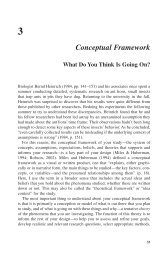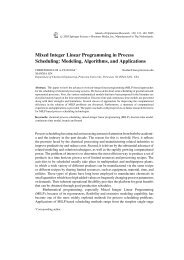Qualitative Research Basics: A Guide for Engineering Educators
Qualitative Research Basics: A Guide for Engineering Educators
Qualitative Research Basics: A Guide for Engineering Educators
You also want an ePaper? Increase the reach of your titles
YUMPU automatically turns print PDFs into web optimized ePapers that Google loves.
perspective: a source of income <strong>for</strong> loggers, a sink <strong>for</strong> carbon dioxide <strong>for</strong><br />
environmentalists, or an object of aesthetic beauty <strong>for</strong> an artist. A study based on<br />
the constructivist perspective seeks to identify a particular meaning and how that<br />
meaning was created by individuals.<br />
Social constructionism: Similar to constructivism, and sometimes considered a<br />
subset of it, this perspective describes meanings as being socially constructed, as<br />
opposed to the individual construction of meaning in constructivism. “…the focus<br />
here is not on the meaning-making activity of the individual mind but on the<br />
collective generation of meaning as shaped by the conventions of language and<br />
other social processes” (Schwandt, quoted in Crotty, 2003, p. 58). Meaning thus is<br />
created in a social context, through interactions between individuals. Meaning<br />
reflects a shared sense of the world, which Crotty (2003) describes as, “…viewing<br />
it (the world) through lenses bestowed on us by culture. Our culture brings things<br />
into view <strong>for</strong> us and endows them with meaning, and, by the same token, leads us<br />
to ignore other things” (p. 54). Similar to the constructivist approach, then, a<br />
social constructionist approach seeks to identify meaning and how that meaning<br />
was created out of the social context that occurs between individuals. Social<br />
constructionism is often considered critical, in that it seeks to examine how the<br />
meanings are derived within a culture.<br />
Symbolic interactionism: Symbolic interactionism focuses on how people act<br />
towards the world around them, based on the meanings that are socially<br />
constructed, but interpreted by the individual. This perspective focuses on<br />
obtaining understanding by placing oneself in the place of the individual. “Only<br />
through dialogue can one become aware of the perceptions, feelings, and attitudes<br />
of others and interpret their meanings and intent” (Crotty, 2003, p. 75). The focus<br />
is on understanding the interactions between people and the world, based on the<br />
meanings given to the world by that individual. Thus, in contrast to social<br />
constructionism, symbolic interactionism is very much uncritical. The researcher<br />
accepts the meanings put into place by the culture and explores their implications.<br />
Hermeneutics: Hermeneutics is primarily concerned with the analysis and<br />
interpretation of texts. Interpretation proceeds through the hermeneutic circle,<br />
which can be used to describe the relationship between the text as a whole and its<br />
individual parts, between the object and the interpreter, and between the<br />
interpreter and the interpreter’s background (Schwandt, 2001, p. 112). In the<br />
hermeneutic circle, the individual parts of a text cannot be understood unless the<br />
whole work is understood, but neither can one gain a meaning of the work as a<br />
whole without understanding the parts. With regard to the interpreter, there is a<br />
feedback in which the background brought to the text in<strong>for</strong>ms the interpretation;<br />
however, that interpretation itself brings about new understanding in the mind of<br />
the interpreter, which can change the way in which the text is seen. Thus, there is<br />
an endless cycle of interpretation (the hermeneutic circle), which leads to endless<br />
evolving interpretations of the text. There is no one “true” meaning <strong>for</strong> the text,<br />
4
















